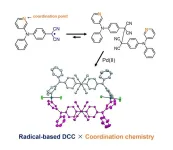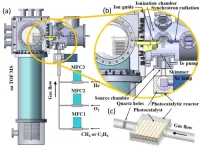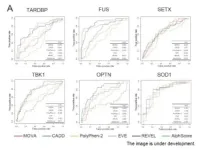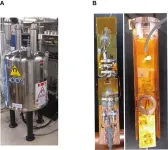(Press-News.org) Women suffering from the autoimmune disease multiple sclerosis temporarily get much better when pregnant. Researchers have now identified the beneficial changes naturally occurring in the immune system during pregnancy. The findings, published in Journal of Neuroinflammation, can show the way to new treatments.
Pregnancy is a very special condition from an immunological point of view. The immune system serves to defend us against foreign substances. However, although half of the genetic material of the foetus comes from the father, it is not rejected by the mother’s immune system. One reason why this balancing act is almost always successful is that during pregnancy the mother’s immune system is adapted to become more tolerant.
In multiple sclerosis, MS, nerve function is hampered due to the immune system attacking the fat that serves as an insulating sheath around the nerve fibres. The nerves become inflamed, which could lead to nerve damage. Although new and more effective treatment options are available, most MS patients deteriorate over time.
Researchers believe that the temporary dampening of the immune response could explain why women with MS actually get better when pregnant. Periods of symptoms, i.e. relapses, decrease by 70 percent during the last third of pregnancy. Also some other autoimmune diseases, such as rheumatoid arthritis, temporarily ameliorate during pregnancy. But the reason for this has not been clear. This is why the researchers behind this study wanted to investigate what mechanisms that could be of particular importance for the decrease in symptoms during pregnancy, as a step to finding future treatment strategies that give the same effect in MS and possibly also other similar diseases.
The researchers were particularly interested in T cells, which play an important role in the immune system. Moreover, T cells play a key role in driving MS and are important during pregnancy. The study compared 11 women with MS to 7 healthy women who had blood samples taken before, during and after pregnancy.
To understand what happens in the immune cells, the researchers identified the genes used in the T cells at various points in time during pregnancy. They also studied changes regulating how genes are switched on and off, i.e. epigenetic changes. In their study, the researchers looked more specifically at one such regulation mechanism called DNA methylation.
“What was possibly most striking is that we couldn’t find any real differences between the groups during pregnancy, as it seems that the immune system of a pregnant woman with MS looks roughly like that of a healthy pregnant woman, says Sandra Hellberg, assistant professor at the Department of Biomedical and Clinical Sciences at Linköping University and one of the researchers behind the study.
The researchers found networks of interacting genes that are affected during pregnancy. Their study shows that these genes are to a large extent linked to the disease and to important processes in the immune system.
“We can see that the changes in the T cells mirror the amelioration in relapse frequency. The biggest changes happen in the last third of pregnancy, and this is where women with MS improve the most. These changes are then reversed after pregnancy at the point in time when there is a temporary increase in disease activity. It is important to stress that disease activity thereafter goes back to what it was prior to the pregnancy,” says Sandra Hellberg.
The network of genes affected during pregnancy also included genes regulated by pregnancy hormones, mainly progesterone. The researchers are now testing various hormones in the lab in an attempt to mimic the effects observed in the study, to see if these can be part of a possible future treatment strategy.
This research is the result of long-standing collaboration between researchers in medicine and bioinformatics. A key part of the project has been understanding the large amount of data by analysing it using what is known as network analysis, developed over many years by, among others, a research group led by Mika Gustafsson at Linköping University. Network analysis is a tool for finding genes that interact extensively with the genes the researchers are interested in. It often turns out that other genes in the network are regulated in an abnormal manner and indirectly affect key processes in a disease.
“Such insights can be used to find alternative medication and find new biomarkers to be able to differentiate between subgroups of a disease. We have used this strategy successfully for analysis in research into for instance allergy and multiple sclerosis”, says Mika Gustafsson, professor of Bioinformatics, who is now making the analysis available to other researchers through a newly founded company.
The study is a sub-study of the GraMS (Pregnancy and MS) study and was carried out in collaboration between Linköping University, the Karolinska University Hospital in Solna, Linköping University Hospital, Länssjukhuset Ryhov in Jönköping and Region Kalmar. The study was funded by the Swedish Foundation for Strategic Research, the Swedish Research Council, NEURO Sweden, the Swedish Foundation for MS Research, Region Östergötland, Linköping University and others.
The article: Prominent epigenetic and transcriptomic changes in CD4+ and CD8+ T cells during and after pregnancy in women with multiple sclerosis and controls, Alberto Zenere, Sandra Hellberg, Georgia Papapavlou Lingehed, Maria Svenvik, Johan Mellergård, Charlotte Dahle, Magnus Vrethem, Johanna Raffetseder, Mohsen Khademi, Tomas Olsson, Marie Blomberg, Maria C. Jenmalm, Claudio Altafini, Mika Gustafsson and Jan Ernerudh, (2023), Journal of Neuroinflammation, published online on 27 April 2023, doi: 10.1186/s12974-023-02781-2
END
Why women with multiple sclerosis get better when pregnant
2023-06-13
ELSE PRESS RELEASES FROM THIS DATE:
Adhering to global health recommendations reduces cancer risk
2023-06-13
People who adhere to global Cancer Prevention Recommendations are putting themselves at lower risk of developing the disease, new research confirms.
Experts at Newcastle University have reviewed evidence of following the 2018 World Cancer Research Fund (WCRF) and American Institute for Cancer Research (AICR) lifestyle-based recommendations.
The findings, published today in Cancer, revealed that adhering to a healthier lifestyle, including maintaining a healthy body weight and eating little red meat and processed meats such as bacon, helps ...
Creation of a new molecule through innovative combination of two reactions
2023-06-13
A research group led by Professor Hideki Fujiwara and Associate Professor Daisuke Sakamaki from the Graduate School of Science at Osaka Metropolitan University succeeded, for the first time, in synthesizing a new molecule using a novel combination of dynamic covalent chemistry, in which organic radicals couple and dissociate reversibly, and coordination chemistry, which binds radicals to metal ligands. The study shows that the two types of reactions work without inhibiting each other.
“This research was based on a very simple idea of combining two types of reactions,” stated Professor Sakamaki. “However, it was not clear ...
Elevated Lipoprotein(a) is the latest variant of ‘bad cholesterol’ found to increase the risk of recurrent coronary heart disease
2023-06-13
Increased levels of Lipoprotein(a), a variant of ‘bad cholesterol’, in the bloodstream are a risk factor for recurrent coronary heart disease (CHD) in people aged 60 or over, according to the results of a new study which tracked the issue over the course of 16 years.
The results, published today in Current Medical Research & Opinion, suggest that current cholesterol-lowering medications may not be effective at reducing the risk of recurrent CHD – such as a heart attack – due to elevated Lp(a).
“This finding adds to growing evidence of a relationship between increased Lp(a) and the risk of recurrent CHD,” says lead author Associate Professor ...
USTC achieves breakthrough in in-situ detection of gas-phase active intermediates in photocatalysis
2023-06-13
Prof. PAN Yang and Associate Researcher LIU Chengyuan, researchers from the University of Science and Technology of China (USTC) of the Chinese Academy of Sciences (CAS), have achieved significant progress in detecting intermediates in methane photocatalytic reactions. Their technique, Synchronous Radiation Photoionization Mass Spectrometry (SR-PIMS), allows for in-situ detection of active intermediates. The findings were published in the prestigious chemistry journal Angewandte Chemie International ...
USTC provides comprehensive review of quantum teleportation in Nature Review Physics
2023-06-13
A team led by Academician Prof. GUO Guangcan from the Chinese Academy of Sciences (CAS) provides a comprehensive overview of the progress achieved in the field of quantum teleportation. The team, which includes Prof. HU Xiaomin, Prof. GUO Yu, Prof. LIU Biheng, and Prof. LI Chuanfeng from the University of Science and Technology of China (USTC),CAS, was invited to publish a review paper on quantum teleportation in Nature Review Physics. The paper was officially released online on May 24.
As one of the most important protocols in the field ...
USTC achieves thousand-kilometer quantum key distribution
2023-06-13
A point-to-point long-distance quantum key distribution (QKD) over a distance of 1,002 km has been achieved by scientists from the University of Science and Technology of China (USTC) of the Chinese Academy of Sciences (CAS), and their collaborators from Tsinghua University, Jinan Institute of Quantum Technology, and Shanghai Institute of Microsystem and Information Technology (SIMIT), CAS. This milestone not only sets a new world record for non-relay QKD but also provides a solution for high-speed intercity quantum communication. The ...
ASHP Summer Meeting Tip Sheet
2023-06-13
Posters
All poster presentations will take place on Monday, June 12, 2023, from 12:15 to 1:30 p.m. EDT, or Tuesday, June 13, 2023, from 12:15 to 1:30 p.m. EDT at the Baltimore Convention Center, Exhibit Hall E, Level 100.
Abstract 4-M (Monday)
Avoiding Clinical Inertia: Comparing Time to Intensification of Glucagon-like
peptide-1 (GLP-1) Receptor Agonists in Patients with Type 2 Diabetes Mellitus Among Clinical Pharmacists versus Providers
Clinical pharmacists have a significant impact on medication optimization and reduction ...
MOVA: new method for evaluating the pathogenicity of missense variants using AlphaFold2
2023-06-13
Niigata, Japan - The Department of Neurology at Niigata University has developed a new in silico method for evaluating the pathogenicity of missense variants using AlphaFold2 (MOVA). Rare variants in the causative gene of ALS are present in 10-30% of sporadic ALS cases, which highlights the need for accurate and efficient pathogenicity prediction methods. To predict the pathogenicity of the variants, in silico analysis methods are commonly used. In some ALS causal genes, the mutations are concentrated in specific regions, and the accuracy of pathogenicity prediction can be improved by considering the positional information of the variants. ...
23Na MRI technique unleashes new approach for diagnosing diabetic kidney disease
2023-06-13
Niigata, Japan - The gold standard test for predicting the onset of diabetic kidney disease is albuminuria. However, detecting albuminuria alone has limited sensitivity and specificity in end-stage renal failure with a decreased estimated glomerular filtration rate. This is supported by several reports, which state that about half of the type 2 diabetes patients who developed kidney dysfunction showed no preceding albuminuria.
In this study, the authors propose the possibility of diagnosing tubular abnormalities in diabetic kidney disease at an early stage and connecting them to treatment by combining the evaluation of sodium concentration using 23Na MRI ...
Immune cell movement worse in older females, mice study finds
2023-06-13
Older female mice had more immune cells entering areas of the body where they shouldn’t according to a new study, demonstrating that sex differences contribute to age-related inflammation that needs to be considered in future research.
In a paper published in Journal of Leukocyte Biology today (Tuesday 13 June), at team of researchers led by Dr Myriam Chimen from the University of Birmingham have found that age significantly increases the number of immune cells entering the sack that holds major organs (peritoneal cavity) in female mice, when compared to young mice or older male mice.
The findings support previous studies that suggest ...







